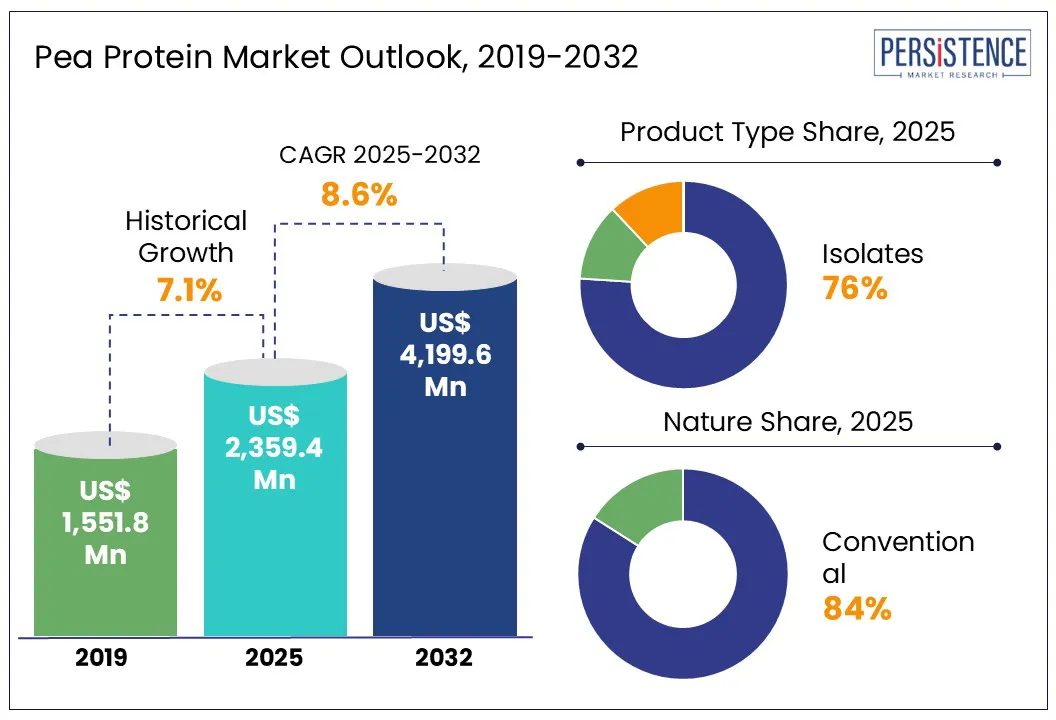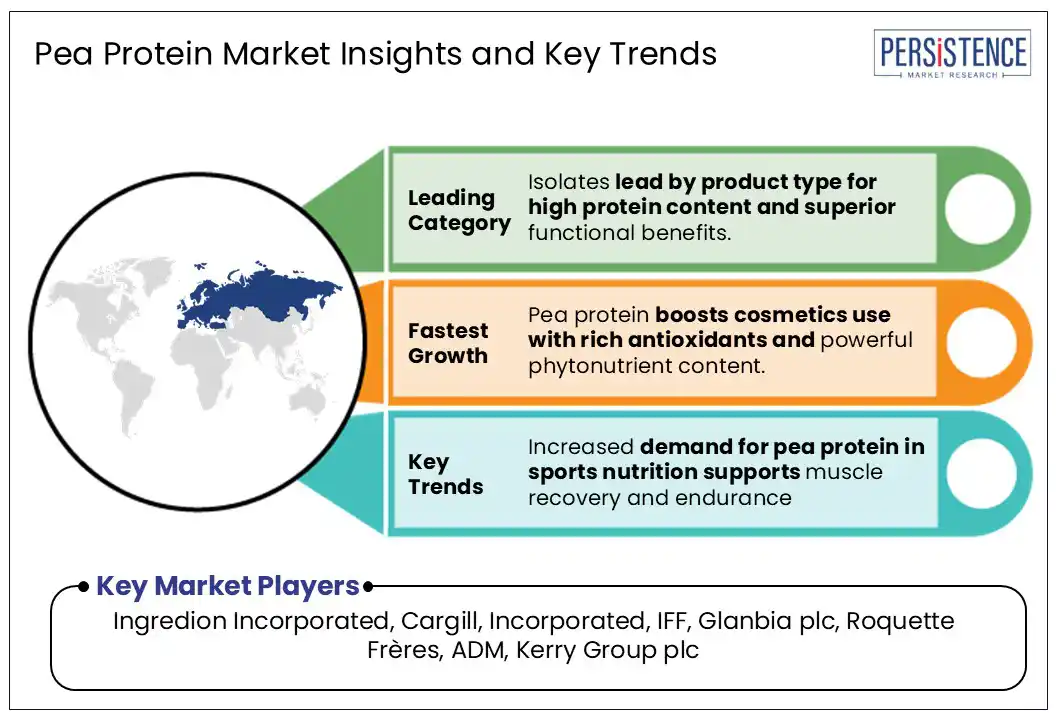ID: PMRREP29284| 307 Pages | 23 Jun 2025 | Format: PDF, Excel, PPT* | Food and Beverages

The global pea protein Market size is likely to be valued at US$2,359.4 million in 2025 to US$4,199.6 million by 2032, growing at a CAGR of 8.6% during the forecast period from 2025 to 2032.
According to Persistence Market Research (PMR), the global pea protein market is evolving beyond traditional food applications, driven by clean-label demand, allergen-free positioning, and the functional versatility of pea protein. Innovation in taste masking, texture enhancement, and sustainable sourcing is enabling its expansion into cosmetics, clinical nutrition, and premium sports supplements across key global markets.

Key Industry Highlights:
|
Global Market Attribute |
Key Insights |
|
Global Pea Protein Market Size (2025E) |
US$ 2,359.4 Mn |
|
Market Value Forecast (2032F) |
US$ 4,199.6 Mn |
|
Projected Growth (CAGR 2025 to 2032) |
7.1% |
|
Historical Market Growth (CAGR 2019 to 2024) |
8.6% |
The growing popularity of vegan, vegetarian, and flexitarian diets is a key factor driving the global demand for pea protein. Health-conscious consumers are increasingly turning to plant-based alternatives that offer both nutritional benefits and environmental sustainability. Pea protein has gained traction due to its high digestibility, hypoallergenic properties, and well-balanced amino acid profile, making it a preferred ingredient in clean-label foods, beverages, and supplements. The flexitarian movement is experiencing rapid growth as more consumers reduce their meat consumption, creating consistent demand for protein-rich alternatives.
According to the Plant Based Foods Association, U.S. sales of plant-based foods grew by more than 6.6% y-o-y basis largely fueled by rising interest in vegetarian and flexitarian diets. This shift in dietary behavior drives innovation in pea protein applications, including dairy alternatives, snacks, and sports nutrition products.
Volatile yields from pea crops are significantly disrupting the stability of the pea protein supply chain. Russia, one of the world's largest producers of yellow peas, is currently facing geopolitical tensions and trade restrictions due to its conflict with Ukraine, which is affecting export flows. Sanctions and trade disputes have further constrained the cross-border movement of agricultural commodities. Additionally, climate change has led to droughts and irregular rainfall patterns in key growing regions, such as Canada and Europe, resulting in reduced harvest volumes and lower quality. Compounding these issues are challenges related to post-harvest storage and processing infrastructure, which lead to additional losses and inefficiencies. As a result, these factors contribute to price volatility and unpredictable availability for pea protein manufacturers.
Establishing strategic partnerships with food manufacturers and research and development (R&D) institutions presents a significant opportunity for pea protein companies to accelerate innovation and expand their market reach. These collaborations provide access to advanced processing technologies, sensory science, and localised consumer insights essential for developing next-generation plant-based products that meet evolving dietary trends. A notable example is the Tropical Food Innovation Lab in Campinas City, Brazil, a collaborative initiative formed by Cargill, Bühler, Givaudan, Food Tech Hub LATAM, and the Institute of Food Technology (ITAL).
This facility supports open innovation through pilot-scale production, formulation testing, and prototyping of sustainable food solutions tailored to both regional and global markets. Such partnerships allow pea protein producers to co-develop products with improved taste, texture, and functionality. By leveraging shared infrastructure and cross-industry expertise, companies can reduce R&D risk, accelerate time to market, and create products that resonate more effectively with health-conscious and environmentally aware consumers.
Pea protein isolates are projected to account for roughly 76% of the market share by the end of 2025. Their dominance stems from their superior purity, functionality, and widespread application across food, beverage, and supplement categories. With a protein content exceeding 80–85%, isolates offer a highly concentrated, plant-based protein source that's both low in allergens and easily digestible. Their neutral flavour profile and improved solubility make them perfect for high-protein formulations like ready-to-drink beverages, meat analogues, and nutritional powders.
Furthermore, their excellent emulsifying, foaming, and gelation properties allow for smooth integration into a diverse array of food systems. This makes them the top choice for manufacturers, aiming for both high performance and clean-label appeal. While isolates lead in market value, pea protein concentrates, which contain 50–60% protein, remain a popular option for more cost-effective formulations. Concentrates are especially well-suited for applications such as bakeries, snacks, and animal nutrition, where extreme protein density isn't the main requirement.
The cosmetics and personal care sector is projected to grow at a fast CAGR during the forecast period, 2025 to 2032. Rich in powerful antioxidants and phytonutrients, pea protein provides anti-inflammatory, anti-ageing, and skin-repairing advantages, making it highly suitable for clean-label formulations in skincare, haircare, and various personal wellness products. Its hypoallergenic nature and plant-based origin align well with consumers' increasing preference for sustainable, non-toxic, and vegan beauty solutions. Pea protein also improves product texture and stability without requiring synthetic additives, which is gaining favour among formulators prioritising transparency and efficacy. Furthermore, the sports and clinical nutrition sectors are propelling additional growth. Pea protein is recognised for its high digestibility, potential for muscle recovery, and its suitability for patients with dietary restrictions or allergies.

The North America pea protein market is expected to grow at an 8.9% CAGR during the forecast period, driven by shifting dietary preferences and industry innovation. In the U.S., the surge in flexitarianism is significantly reshaping protein consumption patterns, as consumers seek plant-based options that align with health and sustainability goals. Improved processing technologies are enhancing the functionality of pea protein, making it more appealing for use in a diverse range of applications.
The clean label movement is also gaining momentum in the U.S., with manufacturers prioritising transparent, allergen-free ingredients. Rising rates of lactose intolerance and gluten sensitivity across the U.S. are further boosting demand for hypoallergenic alternatives like pea protein. Meanwhile, Canada is reinforcing regional supply chains through strategic investments in domestic production. With abundant pea cultivation and strong government-industry collaboration, Canadian plant-based brands are expanding rapidly, contributing to North America's growing influence in the global pea protein market.
Europe dominates the global pea protein market, holding a 37% market share in 2024, driven by regulatory support, consumer awareness, and rapid product innovation. The EU’s “Farm to Fork” strategy, along with various national initiatives, is encouraging sustainable and plant-based food production. European consumers are increasingly scrutinising ingredient lists, preferring natural, minimally processed options, creating strong demand for clean-label pea protein.
Companies such as Roquette in France are heavily investing in R&D to enhance taste and texture, addressing key sensory challenges. The growing health and wellness trend post-pandemic, combined with an established sports and active nutrition market, is further fueling adoption. In markets such as Germany, France, and the UK, innovation is expanding the use of pea protein into fortified bakery items, snacks, and functional beverages. Additionally, the expansion of the retail channel is making pea protein-based products more accessible to mainstream consumers, thereby accelerating market penetration across Europe.
The global pea protein market is experiencing rapid growth, yet it remains fragmented and highly competitive, with companies aggressively innovating to gain market share. Leading players are developing pea protein ingredients that offer optimized functional properties, including improved solubility, taste, and texture, to satisfy diverse application needs. Sustainability is a crucial differentiator, as companies launch regenerative sourcing programs and leverage co-product value streams to maximise resource efficiency. Pre-blended pea protein solutions and application-specific development support are gaining traction, helping food and beverage manufacturers accelerate product launches. Many companies are also investing in novel processing technologies and vertically integrating operations to control quality and reduce costs.
Furthermore, expansion efforts are targeting increased production and distribution networks in high-growth regions such as the Asia Pacific and Latin America, where demand for affordable, allergen-free protein sources is surging. This dynamic landscape continues to drive both innovation and consolidation within the market.
The global pea protein market is projected to be valued at US$ 2,359.4 Mn in 2025.
Widespread adoption of vegan, vegetarian, and flexitarian diets is fueling demand for the global pea protein market.
The global pea protein market is poised to witness a CAGR of 8.6% between 2025 and 2032.
Forming partnerships with food manufacturers and R&D institutions to drive innovation is the key market opportunity.
Major players in the Global Pea Protein market include Ingredion Incorporated, Cargill, Incorporated, IFF, Glanbia plc, Roquette Frères, ADM, Kerry Group plc, and others.
|
Report Attribute |
Details |
|
Historical Data/Actuals |
2019 - 2024 |
|
Forecast Period |
2025 - 2032 |
|
Market Analysis |
Value: US$ Mn, Volume: Tons |
|
Geographical Coverage |
|
|
Segmental Coverage |
|
|
Competitive Analysis |
|
|
Report Highlights |
|
|
Customization and Pricing |
Available upon request |
By Product Type
By Nature
By End-use
By Distribution Channel
By Region
Delivery Timelines
For more information on this report and its delivery timelines please get in touch with our sales team.
About Author